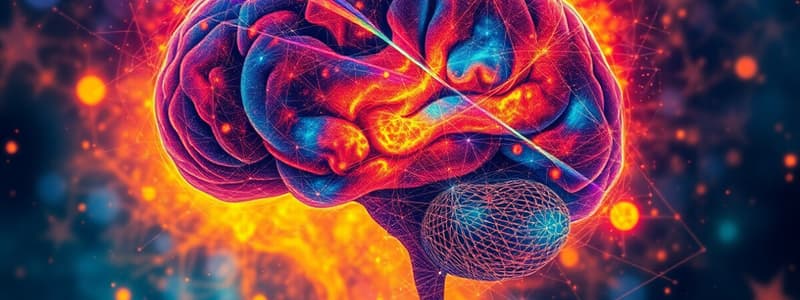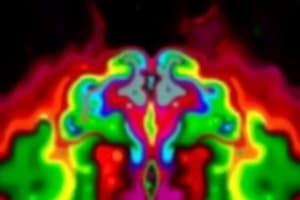Podcast
Questions and Answers
What does neuroimaging primarily help to understand in psychosis research?
What does neuroimaging primarily help to understand in psychosis research?
- Environmental factors alone
- Aetiology and cognitive models (correct)
- Social media influences
- Behavioral therapy methods
Which neuroimaging method involves the use of a radio-tracer?
Which neuroimaging method involves the use of a radio-tracer?
- MRI
- sMRI
- PET (correct)
- EEG
What type of neuroimaging provides structural information?
What type of neuroimaging provides structural information?
- MRS
- MEG
- fMRI
- sMRI (correct)
Which of the following is NOT a factor linked to the aetiology of psychosis?
Which of the following is NOT a factor linked to the aetiology of psychosis?
What aspect of psychosis does neuroimaging assist in regarding therapeutic approaches?
What aspect of psychosis does neuroimaging assist in regarding therapeutic approaches?
Which factors mentioned contribute to the final common pathway in psychosis understanding?
Which factors mentioned contribute to the final common pathway in psychosis understanding?
Who conducted early research linking CT scans to enlarged ventricular size in psychosis?
Who conducted early research linking CT scans to enlarged ventricular size in psychosis?
Which neuroimaging technique is considered functional imaging?
Which neuroimaging technique is considered functional imaging?
Which of the following is a reason for utilizing neuroimaging in psychosis research?
Which of the following is a reason for utilizing neuroimaging in psychosis research?
What aspect of neuroimaging methods does DTI primarily focus on?
What aspect of neuroimaging methods does DTI primarily focus on?
Which method of neuroimaging assesses the neurochemical activity in the brain?
Which method of neuroimaging assesses the neurochemical activity in the brain?
What is a significant issue related to neuroimaging research methods in understanding psychosis?
What is a significant issue related to neuroimaging research methods in understanding psychosis?
Which factor is NOT associated with the final common pathway regarding psychosis?
Which factor is NOT associated with the final common pathway regarding psychosis?
Which of the following neuroimaging methods captures both structural and functional information?
Which of the following neuroimaging methods captures both structural and functional information?
What does imaging, such as CT scanning, reveal in psychosis research?
What does imaging, such as CT scanning, reveal in psychosis research?
Which neuroimaging technique requires the injection of a radio-tracer?
Which neuroimaging technique requires the injection of a radio-tracer?
What is the significance of viewing schizophrenia as a dimensional concept rather than a categorical illness?
What is the significance of viewing schizophrenia as a dimensional concept rather than a categorical illness?
Which of the following is a clinical high-risk criterion for psychosis?
Which of the following is a clinical high-risk criterion for psychosis?
Why is neuroimaging important in understanding psychosis?
Why is neuroimaging important in understanding psychosis?
What was revealed by Johnstone et al. in their 1976 neuroimaging study related to schizophrenia?
What was revealed by Johnstone et al. in their 1976 neuroimaging study related to schizophrenia?
What does the term 'final common pathway' in the context of psychosis refer to?
What does the term 'final common pathway' in the context of psychosis refer to?
Flashcards
Neuroimaging in Psychosis Research
Neuroimaging in Psychosis Research
Neuroimaging techniques are used to study the brain in psychosis, to understand its causes (etiology), cognitive/biological models, diagnosis, and treatment.
Neuroimaging methods
Neuroimaging methods
Methods like MRI (structural and functional), PET/SPECT, EEG/MEG, and MRS are used to analyze brain structure, function, and neurochemistry.
MRI (Magnetic Resonance Imaging)
MRI (Magnetic Resonance Imaging)
A neuroimaging technique producing detailed images of brain structure and function.
PET/SPECT (Positron Emission Tomography/Single-Photon Emission Computed Tomography)
PET/SPECT (Positron Emission Tomography/Single-Photon Emission Computed Tomography)
Signup and view all the flashcards
EEG/MEG (Electroencephalography/Magnetoencephalography)
EEG/MEG (Electroencephalography/Magnetoencephalography)
Signup and view all the flashcards
Aetiology of Psychosis
Aetiology of Psychosis
Signup and view all the flashcards
Structural Neuroimaging
Structural Neuroimaging
Signup and view all the flashcards
Functional Neuroimaging
Functional Neuroimaging
Signup and view all the flashcards
Why Study the Brain in Psychosis?
Why Study the Brain in Psychosis?
Signup and view all the flashcards
Factors Influencing Psychosis
Factors Influencing Psychosis
Signup and view all the flashcards
Neurochemical Neuroimaging
Neurochemical Neuroimaging
Signup and view all the flashcards
PET/SPECT
PET/SPECT
Signup and view all the flashcards
Johnstone et al. 1976 Study
Johnstone et al. 1976 Study
Signup and view all the flashcards
Clinical High Risk for Psychosis
Clinical High Risk for Psychosis
Signup and view all the flashcards
Psychosis Continuum
Psychosis Continuum
Signup and view all the flashcards
Attenuated Psychosis Syndrome
Attenuated Psychosis Syndrome
Signup and view all the flashcards
Johnstone et al.'s 1976 CT Scanning Study
Johnstone et al.'s 1976 CT Scanning Study
Signup and view all the flashcards
Brief Limited Intermittent Psychosis (BLIP)
Brief Limited Intermittent Psychosis (BLIP)
Signup and view all the flashcards
Study Notes
Neuroimaging in Psychosis Research
- Neuroimaging techniques, like MRI, PET, SPECT, EEG, and MEG, are used to study brain structure and function in psychosis research.
- Specific types of MRI include structural (sMRI), diffusion tensor imaging (DTI), functional (fMRI), and magnetic resonance spectroscopy (MRS).
- Positron emission tomography (PET) requires radioactive tracers to visualize receptor activity in the brain.
- Electroencephalography (EEG) and magnetoencephalography (MEG) measure electrical and magnetic brain activity, respectively.
Aetiology/Cause of Psychosis
- Schizophrenia is understood as a dimensional, rather than categorical, illness, with varying degrees of severity.
- Clinical high-risk (CHR) states for psychosis involve emerging symptoms, and some individuals will transition to psychosis.
- Early-life factors such as obstetric complications, childhood trauma, marginalized group status, substance use, and socioeconomic factors influence brain development, possibly contributing to psychosis risk.
- Neuroimaging studies are crucial to understand brain structure and function in psychosis and to identify potential causal factors involved.
Brain Structure in Schizophrenia
- Neuroimaging studies show alterations in brain structure in schizophrenia, such as reduced grey matter volume in specific areas, like the frontal and temporal lobes, and differences in cortical thickness and subcortical volumes (e.g. hippocampus, amygdala, thalamus, striatum).
- These changes might be developmental or neurodegenerative, potentially influenced by early-life experiences.
- Antipsychotic medication can also affect brain structure over time.
- The right anterior cingulate, insula, thalamus, and temporal gryus are among the areas affected.
Neurodevelopmental Trajectories in Schizophrenia
- Early-life factors interact with genetic predispositions to affect brain development which can lead to schizophrenia.
- Longitudinal studies are needed to pinpoint the timing of neurodevelopmental changes in psychosis onset to further understand the pathogenesis of the disorder.
- Schizophrenia is better characterized as a spectrum disorder that may be associated with different neurodevelopmental trajectories versus a purely neurodegenerative process.
Biological Models and Psychosis
- Neuroimaging can be used to evaluate the dopamine hypothesis of psychosis.
- PET imaging assesses dopamine receptor binding, synaptic dopamine uptake, and dopamine synthesis capacity.
- Elevated dopamine activity is observed in certain brain regions (e.g., striatum) in schizophrenia compared to healthy controls. More research remains necessary.
- The dopamine hypothesis struggles to explain all aspects of psychosis, implying a multi-system etiologic process.
- Other neurotransmitters besides dopamine may be involved in the development of schizophrenia.
Diagnosis and Measurement
- Diagnosis of psychosis often relies on clinical evaluations and subjective assessments, with ongoing efforts to use objective biological measures, like neuroimaging, to inform or aid these diagnoses.
- Challenges remain with standardization, variability in data across patient groups and settings, and with identifying biomarkers and methods that offer useful diagnostic assistance to improve the accuracy and objectivity of diagnoses.
Current Research Directions
- Longitudinal studies, including neuroimaging, are crucial to observe brain changes before and during the development of psychosis.
- Further exploration is required to understand the trajectory of the disease and the impact of various risk factors and potentially treatments.
- Advanced methods, such as machine learning, can potentially enhance predictions of psychosis, offering better-guided treatment decisions in early stages and improving prognosis prediction.
Studying That Suits You
Use AI to generate personalized quizzes and flashcards to suit your learning preferences.




